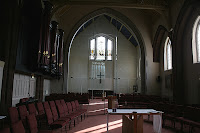It was a Saturday morning, I had gone to have the tyres changed on the car and I decided that I could do the walk down Preston New Road, visit the memorial and head back. However Blackpool away from the seafront is just like any suburban town and has a wealth of history just waiting to found. I went down Preston Old road instead, took photos in
Marton Burial Ground, unusually there does not seem to be a church "looking after" it , found a
boundary marker that I didn't know existed, took photos of the "
Boars Head", and the hall opposite. There are some older cottages there too - they also ended up in the memory card too. Turned onto Whitegate drive at the "
Saddle" pub, which is the longest permanently licensed pub in Blackpool. There is a
shot up Preston Old Road from here.
 |
| The inscription |
 |
| St Pauls Memorial |
 |
| John Picken Dixon |
 |
| The Outside of the Church |
 |
| The inside of the church |
The church is set back from the road and there is a pleasant clump of trees in front of the church. The memorial is set in front of the grass and is on the corner of a side road and Whitegate Drive. I walked around the church, there are some quite unusual features. The bell tower is set very low. There are no gravestones to be found. There is a tasteful foundation stone set in the church wall commemorating the founder of the church, John Picken Dixon. A biography is found
here. The biography states that some members of the family are buried in the crypt at the church. The founder and his family have had a very illustrious career as an industrialist as well as having a huge influence in Blackpool and in particular, Marton. It is quite a large size and is made of fine red brick, very much a traditional build - It is quite a modern church, but the surprises lie within. No pews - Apparently there was quite a bit of resistance from some members of the congregation. Looks good though! There were some ladies setting up for a Saturday coffee morning, on remarking there was very little in the way of ornamentation she showed me through the offices.
 |
| Cookson Memorial |
 |
| Cookson Memorial |
 |
| Metal Plaque inside Church |
The memorial plaques to the first incumbent and his family. All three plaques are dedicated to the Cookson family whose origins clearly hark back to South Lakeland. A church definitely worth a visit! There is the compete list of the names on the memorial
here as well as some more pictures of the church








